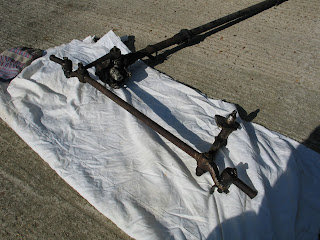Well, two years has passed since my last update and you may therefore think that nothing has happened with the restoration or that I am no longer involved with it - for whatever reason.
Neither assumption is correct although it is true that progress has been very much slower than I had planned - do I hear a chorus of 'tell me about it!'. As work in the garden is now getting less demanding, I intend to re-commence work on 1 September, and it's important that readers should be brought up to date with the progress - however small - during the last two years.
An important milestone, putting all other achievements into insignificance, took place on 12 May this year when, using an ignition, cooling and battery lash-up, the engine ran for the first time since 1978!
However, this was a short-lived run of only about twenty seconds.
The setting-up of the twin SU carbs. consisted of the basic, initial positioning of the chokes and throttles as prescribed on the 50-year old instructions that I had obtained from the SU stand at an Earl's Court Motor Show in the early 1960s and I initially thought that incorrect setting was the reason for the problem.
The AC Delco fuel pump had been stripped, cleaned and re-assembled using the old diaphragm and valves as I could not see any fault with them. However, as all my other investigations into timing, ignition coil operation, distributor points gap and the carb. settings lead nowhere, I had to conclude that the pump components were at fault.
I was pointed in the direction of a likely supplier of a refurb kit and one eventually arrived. After fitting the new diaphragm - I've no idea if it it subject to attack by the modern petrol that I am using - and also the two valves, even though I could see nothing wrong with the originals dating from the 1970s, I prepared the lash-up again, pushed the bodyless car outside the garage, primed the carbs - the priming lever on the pump is very useful - and applied 12 volts to the starter motor and ignition circuit.
The engine started first time and continued running without problem for the next 25 minutes whilst the engine flushing oil did its job. I had also put flushing oil into the gearbox and, as the prop. shaft is not yet connected, was able to select the gears without difficulty and so check that nothing untoward had taken place inside the box.
Draining it and the sump while the oil was hot was the next task and then I noticed that coolant was coming out of the cap on the header tank. Examination showed that during the rebuild of the radiator, the top (two-inlet) connector had been re-aligned. The result was that the hose connecting to the header tank was lower than that connecting to the thermostat housing and so an air blockage was created in the housing.
I have now fitted a domestic heating radiator bleed valve to the brass nut on the top of the housing.
The work that has been completed over the last two years includes the obvious re-fitting of the power train, a stainless steel exhaust box (again routed under the driving seat as I always had difficulty in finding a route to the rear of the car, for the pipe and box, that did not invite damage on our local country roads), fitting new, copper, brake and clutch piping, drilling a breather hole in the top bolt of the axle differential box and checking out the complete wiring loom before applying replacement binding tape.
Checking for lubrication and hydraulic oil leaks will be my first task and then I shall tackle the production of a new, fibre-glass passenger floor. The original marine ply floor had been replaced with a sheet metal version in the early 70s but proved to be incapable of further use when the car was dis-assembled. I have not yet decided whether to fit a foot-pan as per that on the driving side floor - it may not be worth the effort!
So, watch this space!








